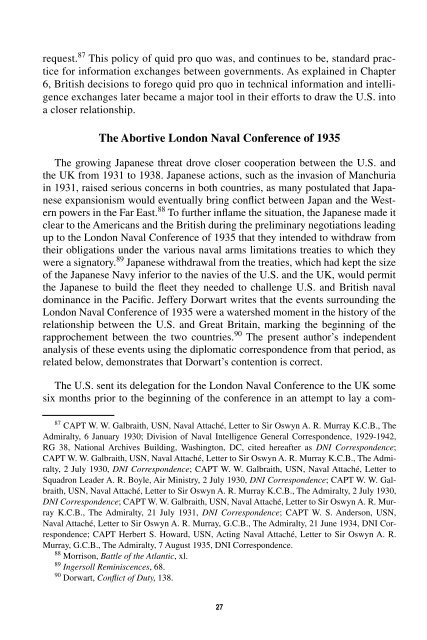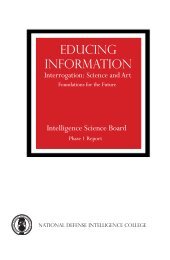equest. 87 This policy of quid pro quo was, and continues to be, standard practicefor information exchanges between governments. As explained in Chapter6, British decisions to forego quid pro quo in technical information and intelligenceexchanges later became a major tool in their efforts to draw the U.S. intoa closer relationship.The Abortive London Naval Conference of 1935The growing Japanese threat drove closer cooperation between the U.S. andthe UK from 1931 to 1938. Japanese actions, such as the invasion of Manchuriain 1931, raised serious concerns in both countries, as many postulated that Japaneseexpansionism would eventually bring conflict between Japan and the Westernpowers in the Far East. 88 To further inflame the situation, the Japanese made itclear to the Americans and the British during the preliminary negotiations leadingup to the London Naval Conference of 1935 that they intended to withdraw fromtheir obligations under the various naval arms limitations treaties to which theywere a signatory. 89 Japanese withdrawal from the treaties, which had kept the sizeof the Japanese Navy inferior to the navies of the U.S. and the UK, would permitthe Japanese to build the fleet they needed to challenge U.S. and British navaldominance in the Pacific. Jeffery Dorwart writes that the events surrounding theLondon Naval Conference of 1935 were a watershed moment in the history of therelationship between the U.S. and Great Britain, marking the beginning of therapprochement between the two countries. 90 The present author’s independentanalysis of these events using the diplomatic correspondence from that period, asrelated below, demonstrates that Dorwart’s contention is correct.The U.S. sent its delegation for the London Naval Conference to the UK somesix months prior to the beginning of the conference in an attempt to lay a com-87 CAPT W. W. Galbraith, USN, Naval Attaché, Letter to Sir Oswyn A. R. Murray K.C.B., TheAdmiralty, 6 January 1930; Division of Naval <strong>Intelligence</strong> General Correspondence, 1929-1942,RG 38, <strong>National</strong> Archives Building, Washington, DC, cited hereafter as DNI Correspondence;CAPT W. W. Galbraith, USN, Naval Attaché, Letter to Sir Oswyn A. R. Murray K.C.B., The Admiralty,2 July 1930, DNI Correspondence; CAPT W. W. Galbraith, USN, Naval Attaché, Letter toSquadron Leader A. R. Boyle, Air Ministry, 2 July 1930, DNI Correspondence; CAPT W. W. Galbraith,USN, Naval Attaché, Letter to Sir Oswyn A. R. Murray K.C.B., The Admiralty, 2 July 1930,DNI Correspondence; CAPT W. W. Galbraith, USN, Naval Attaché, Letter to Sir Oswyn A. R. MurrayK.C.B., The Admiralty, 21 July 1931, DNI Correspondence; CAPT W. S. Anderson, USN,Naval Attaché, Letter to Sir Oswyn A. R. Murray, G.C.B., The Admiralty, 21 June 1934, DNI Correspondence;CAPT Herbert S. Howard, USN, Acting Naval Attaché, Letter to Sir Oswyn A. R.Murray, G.C.B., The Admiralty, 7 August 1935, DNI Correspondence.88 Morrison, Battle of the Atlantic, xl.89 Ingersoll Reminiscences, 68.90 Dorwart, Conflict of Duty, 138.27
mon framework for negotiation with the British, which would give both countriesa better bargaining position against the Japanese. At the start of negotiations, U.S.and British goals for the conference were diametrically opposed. Norman Davis,the Chairman of the U.S. Delegation, was given orders by Franklin Roosevelt topursue a 20 percent across-the-board reduction for naval forces and a 10- to 15-year extension to the terms of all existing naval arms limitations treaties then ineffect. If the 20 percent reduction could not be attained, the fallback position wasto have the British agree to maintain parity with the U.S. in naval forces. 91 PresidentRoosevelt instructed Davis to present the U.S. goals personally to PrimeMinister MacDonald, and to argue that the reduction in forces was needed to easetensions in the world. Other factors, such as fiscal constraints and American isolationistsentiments, were most likely just as significant in Roosevelt’s decision toadvocate for naval force reductions. 92 Reporting on his conversations with Mac-Donald to the President and Secretary of State, Cordell Hull, Davis reported thatthe British had actually been hoping the U.S. would agree to an increase in Britishnaval forces and they believed the U.S. did not truly understand how much theworld situation had changed since the last naval arms limitations talks, which hadbeen held in London in 1930. In particular, the British desired a substantialincrease in their cruiser strength, telling Davis that “in 1930 England and Americafaced a single problem, namely, the Japanese; whereas today America stillfaces only this single problem, England now also faces the acute problem ofEurope which is relatively academic to the United States.” 93 Although both sidesseemed diametrically opposed, within a few months of these conversations thedifferences in U.S. and the UK positions would become irrelevant in the face ofthe need to develop a common understanding of how best to respond to Japan’sdecision to abrogate its treaty obligations.The development of this common understanding would take place in the contextof a series of frank discussions between the American and British delegations,some of which were attended by the British Prime Minister. As winterapproached, negotiations no longer focused on U.S. desires to reduce naval forcesbecause the Japanese decision had made that position untenable for the Americans.During a discussion in November 1934, the British did attempt to get theU.S. to agree on a position concerning higher “qualitative” limits on naval cruiserstrength, but the U.S. delegation remained noncommittal. The major concern of91The Ambassador in Great Britain (Bingham) to the Secretary of State, 19 June 1934, in ForeignRelations of the United States 1934 1 (Washington, DC: GPO, 1951), 262. Cited hereafter asFRUS 1934 vol. 1. This cable, released by Ambassador Bingham, was actually from Norman Davis.92 The Secretary of State to the Ambassador in Great Britain (Bingham), 26 June 1934, in FRUS1934 vol. 1, 277.93 The Ambassador in Great Britain (Bingham) to the Secretary of State, 27 June 1934, in FRUS1934 vol. 1, 279.28
- Page 1 and 2: COURTING A RELUCTANT ALLYAn Evaluat
- Page 4: The Joint Military Intelligence Col
- Page 8 and 9: FOREWORDTo most Americans alive tod
- Page 10 and 11: PROLOGUESince World War II, the Uni
- Page 12 and 13: Chapter 1THE STATUS OF INTELLIGENCE
- Page 14 and 15: action, a propaganda unit, or an ec
- Page 16 and 17: officers assisted by 20 civilian cl
- Page 18 and 19: ships in violation of treaty limits
- Page 20 and 21: assessments. By 1941, ONI was releg
- Page 22 and 23: might bear on their work.” 39 As
- Page 24 and 25: ility over time, its operational in
- Page 26 and 27: Chapter 2U.S.-UK RELATIONS, 1914-19
- Page 28 and 29: told by the Chief of Naval Operatio
- Page 30 and 31: ups of the early 20th century. 65 T
- Page 32 and 33: firmly believed that British polici
- Page 34: ecame one of the primary sources of
- Page 37: of shoring up their strategic weakn
- Page 43 and 44: assuaged British concerns about the
- Page 45 and 46: In the area of intelligence exchang
- Page 47 and 48: clear to the Americans that if they
- Page 49 and 50: in his mind worked against closer c
- Page 51 and 52: praised the fighting spirit of the
- Page 53 and 54: through November of 1940 persuaded
- Page 55 and 56: and Great Britain. His principalcon
- Page 57 and 58: eceived by the British and from the
- Page 59 and 60: gear designed by the British. Altho
- Page 61 and 62: American Attitudes On Intelligence
- Page 63 and 64: information did have an impact on K
- Page 65 and 66: the affair. 183 This lack of resent
- Page 67 and 68: tion exchanges. Even more significa
- Page 69 and 70: nation (BSC) mission, is now availa
- Page 71 and 72: good will and encouraged greater co
- Page 73 and 74: would merely show Donovan “the be
- Page 75 and 76: Lothian passed Hill’s proposal to
- Page 77 and 78: still a powerful influence. While Z
- Page 79 and 80: Since the Tizard Mission had only a
- Page 81 and 82: appropriating large increases to th
- Page 83 and 84: the French, a point which would not
- Page 85 and 86: equested that RADM Ghormley remain
- Page 87 and 88: when he [Pott] comes to O.N.I. he i
- Page 89 and 90:
it was not official U.S. policy. St
- Page 91 and 92:
efforts that had begun with the Sta
- Page 93 and 94:
high-level ABC-1 staff talks which
- Page 95 and 96:
to successfully interpret the instr
- Page 97 and 98:
to little more than a nebulous stat
- Page 99 and 100:
to offer.” 319 Others in the Brit
- Page 101 and 102:
Operational Intelligence Cooperatio
- Page 103 and 104:
Godfrey’s main concern was most l
- Page 105 and 106:
possesses complementary capabilitie
- Page 107 and 108:
2. Be prepared to give something of
- Page 109 and 110:
had in forming its own Joint Intell
- Page 112 and 113:
GLOSSARYABC-1ALUSNALondonBGENBSCCAP
- Page 114 and 115:
APPENDIX AA NOTE ON SOURCESArchival
- Page 116:
APPENDIX BMAJOR EVENTS IN U.S.-UK I
- Page 119 and 120:
________. Foreign Relations of the
- Page 121 and 122:
________. “The Secret of the Chur
- Page 123 and 124:
Zacharias, Ellis M., CAPT, USN. Sec
- Page 126 and 127:
INDEXAABC-1 Talks 41, 57, 74-75, 78
- Page 128 and 129:
IImagery Intelligence (IMINT) 12, 8
- Page 130 and 131:
Signals Intelligence(SIGINT) 2-3, 7
- Page 132:
PCN 53512ISBN 0-9656195-9-1
















